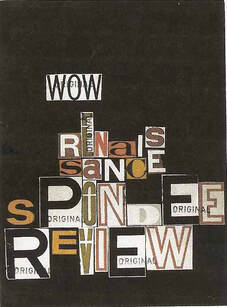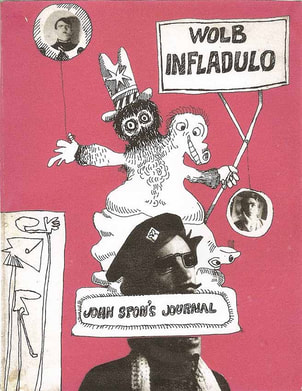| By Marian Quigley ART journals that formed part of a regular interchange between Phillip Island artist John Adam (aka John Spon) and his late friend, the renowned Australian artist Robert Rooney, have been acquired by the National Gallery of Victoria and are likely to be exhibited there in the future. John took his journals to the NGV earlier this year following a request from Trevor Fuller, who was researching a biography of Robert Rooney. The NGV already has approximately 30 of the journals Robert produced in their collection. In February, John received a letter from NGV Director Tony Ellwood stating that they “will make an invaluable addition to the NGV’s representation of the 1960s art movements in Melbourne. They will also complement our expanding collection of work by Robert Rooney and help to contextualise the Spon phenomenon”. |
The collection John donated consists of 27 collage books, called “Spons” which he produced and sent to Robert in the 1960s when John was teaching at Sale Technical College. These were satirical journals based in part on John’s observations of life in Sale.
Comprising drawings, poems, mixed typography and collage, “Spons” derived their title and their absurdist humour from the 1950s British radio comedy series The Goon Show, which featured Spike Milligan, Harry Secombe and Peter Sellers. In the show, the term “Spon” was used freely. For example, “Spon Plague” referred to a disease that attacked the knees of its victims whilst “The Evils of Bushey Spon” referred to a backward village.
Comprising drawings, poems, mixed typography and collage, “Spons” derived their title and their absurdist humour from the 1950s British radio comedy series The Goon Show, which featured Spike Milligan, Harry Secombe and Peter Sellers. In the show, the term “Spon” was used freely. For example, “Spon Plague” referred to a disease that attacked the knees of its victims whilst “The Evils of Bushey Spon” referred to a backward village.
 Spondee Review cover, by Robert Rooney
Spondee Review cover, by Robert Rooney “Spon” had its origins amongst a group of art students enrolled in the final year of the Diploma of Arts course at Swinburne Technical College in 1957. These included Robert Rooney, Dale Hickey, Bill Sykes, Lesley Ann Davidson and John’s first wife, Rosemary Adam, whom he had married that year. John had completed the Diploma the year before. In an article entitled “Spons I have Seen”, which she wrote for the catalogue of a 1990 Robert Rooney exhibition at Monash University Gallery, Rosemary explains:
“Spon took from the Goons a dada sense of the absurd and the iconoclastic, together with a spontaneity akin to Surrealist automatism, or the free association of words, images and thoughts. The innovative writing style of Gertrude Stein and Jack Kerouac’s spontaneous prose and poetry also played an important part in the formation of Spon, as did jazz and rock ’n’ roll.”
Spon activities continued amongst the group after they left Swinburne. When Robert worked at Halls Bookstore in Prahran, he collected oddments – illustrated books on curious activities such as Swedish club swinging or exercising in the bath, as well as comical or pathetic objects which readers had left inside books. He termed these “Rott” and would use them to make art, pasting some into booklets and posting them to John and Rosemary when they first lived in Melbourne. He also produced The Spondee Review, an arts review parodying the American Evergreen Review which published new work by the Beat poets and writers.
The Spon group, which was unstructured, later expanded to include a range of like-minded people in the fields of music, art and literature who would gather at various places including John and Rosemary’s home.
Rosemary Adam claims that whilst Spon production reached its height in 1960-1962 with the correspondence between John and Robert, its essence can still be seen in some of Rooney’s paintings and photography from the 1960s to the 1980s.
John explains that Spon for him was spontaneous and he used whatever came to hand to create his journals. His own interest in the absurd and the ridiculous was inspired not only by the Goons and the Surrealist and Dadaist art movements but by a range of writers including C. J. Dennis, Edward Lear, Lewis Carroll, James Joyce and Ogden Nash.
However, whilst John was merely having fun with the journals he created, he believes Robert, who was always aware of his place in history, regarded his own creations more seriously. Although Robert failed his Diploma because his work didn’t fit the institution’s criteria, John believes Robert was probably one of Swinburne’s best and most versatile artists who went on to become famous as an artist, photographer and musician and later, an art critic for the Age and Australian newspapers. He regards Robert as a unique figure, shy and small in stature but an artist who could turn trivial or everyday objects into works of art – his abstract paintings were sometimes based on knitting patterns or Cornflake packets.
John, who moved to Phillip Island in 2000, sees himself as less ambitious, describing himself as an “amateur” who, despite winning the award for best newcomer at the 1967 Georges Invitation Exhibition with an abstract painting, continued to paint landscapes because he enjoyed it. Anyone who has seen his work would very likely have a different opinion!
“Spon-dering” on the past, John realises how lucky he was to have been immersed in the heady days of the Melbourne art world of the 1960s and 1970s in particular, during which he mixed with so many of its up and coming artists.
At the age of 84, John continues to teach local artists. Ironically, he has recently returned to some of the techniques of the Spon journals, creating collages using found objects and natural materials, sometimes superimposing these on his older paintings.
“Spon took from the Goons a dada sense of the absurd and the iconoclastic, together with a spontaneity akin to Surrealist automatism, or the free association of words, images and thoughts. The innovative writing style of Gertrude Stein and Jack Kerouac’s spontaneous prose and poetry also played an important part in the formation of Spon, as did jazz and rock ’n’ roll.”
Spon activities continued amongst the group after they left Swinburne. When Robert worked at Halls Bookstore in Prahran, he collected oddments – illustrated books on curious activities such as Swedish club swinging or exercising in the bath, as well as comical or pathetic objects which readers had left inside books. He termed these “Rott” and would use them to make art, pasting some into booklets and posting them to John and Rosemary when they first lived in Melbourne. He also produced The Spondee Review, an arts review parodying the American Evergreen Review which published new work by the Beat poets and writers.
The Spon group, which was unstructured, later expanded to include a range of like-minded people in the fields of music, art and literature who would gather at various places including John and Rosemary’s home.
Rosemary Adam claims that whilst Spon production reached its height in 1960-1962 with the correspondence between John and Robert, its essence can still be seen in some of Rooney’s paintings and photography from the 1960s to the 1980s.
John explains that Spon for him was spontaneous and he used whatever came to hand to create his journals. His own interest in the absurd and the ridiculous was inspired not only by the Goons and the Surrealist and Dadaist art movements but by a range of writers including C. J. Dennis, Edward Lear, Lewis Carroll, James Joyce and Ogden Nash.
However, whilst John was merely having fun with the journals he created, he believes Robert, who was always aware of his place in history, regarded his own creations more seriously. Although Robert failed his Diploma because his work didn’t fit the institution’s criteria, John believes Robert was probably one of Swinburne’s best and most versatile artists who went on to become famous as an artist, photographer and musician and later, an art critic for the Age and Australian newspapers. He regards Robert as a unique figure, shy and small in stature but an artist who could turn trivial or everyday objects into works of art – his abstract paintings were sometimes based on knitting patterns or Cornflake packets.
John, who moved to Phillip Island in 2000, sees himself as less ambitious, describing himself as an “amateur” who, despite winning the award for best newcomer at the 1967 Georges Invitation Exhibition with an abstract painting, continued to paint landscapes because he enjoyed it. Anyone who has seen his work would very likely have a different opinion!
“Spon-dering” on the past, John realises how lucky he was to have been immersed in the heady days of the Melbourne art world of the 1960s and 1970s in particular, during which he mixed with so many of its up and coming artists.
At the age of 84, John continues to teach local artists. Ironically, he has recently returned to some of the techniques of the Spon journals, creating collages using found objects and natural materials, sometimes superimposing these on his older paintings.
